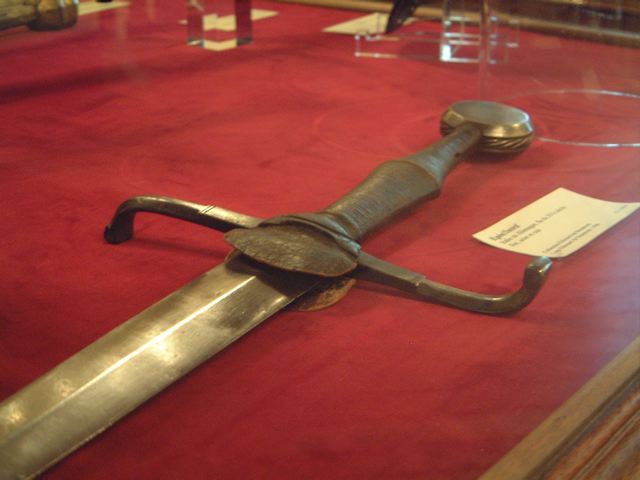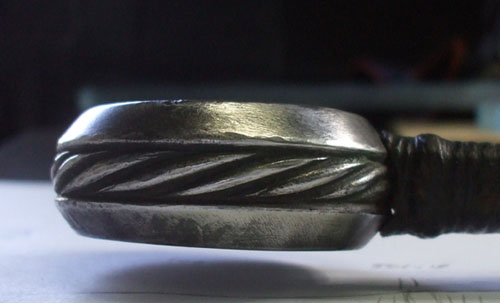| Author |
Message |
|
Justin King
Industry Professional
|
 Posted: Sun 22 Mar, 2009 8:17 am Post subject: Question about a pommel Posted: Sun 22 Mar, 2009 8:17 am Post subject: Question about a pommel |
 |
|
This sword in the Cluny Museum has my interest and I am wondering more and more if the pommel is solid or if it might be of 3-piece sandwich type contruction, with a ring forming the center and flat plates for the outsides, and brazed together. It looks rather massive to be solid, it seems as if it might over-balance the sword. The "roping" or fluting around the circumference also makes me wonder if this was not filed onto the center piece before the outside faces were brazed on. If anyone has examined this sword closely or cares to offer an educated guess I would much appreciate it. I am not sure if this type of pommel construction was typical in this period but it was certainly not unknown.
 Attachment: 38.57 KB Attachment: 38.57 KB

 Attachment: 31.09 KB Attachment: 31.09 KB

|
|
  |
 |
|
Peter Johnsson
Industry Professional
|
 Posted: Sun 22 Mar, 2009 8:49 am Post subject: Posted: Sun 22 Mar, 2009 8:49 am Post subject: |
 |
|
Hey Justin,
I have documented this sword during a study trip to Paris (with Fabrice Cognot as my host and fellow researcher).
Initially I was half expecting to see a faint line suggesting brazing (with a construction just like the one you suggested). There was no such in evidence.
It may still be hollow and even three piece construction. It might also be a case of skillful work with files and chisels. There could also be a slight hollow inside, as result of forging of the hole for the tang (a pretty common thing). There is no way to know this just by visual inspection, and I have yet to make a detailed reconstruction or practical study of the sword (that shall happen later on).
The pommel *could* be pretty much solid: the blade is slim in outline, but not flimsy in cross section. I do not think it has to be much hollowed out to avoid the sword to be hilt heavy.
In all, the sword is wonderfully light: a hand & half rapier. It has a number of obvious scars from an encounter with another sharp blade, even though it is not heavily worn.
|
|
   |
 |
|
Justin King
Industry Professional
|
 Posted: Sun 22 Mar, 2009 9:28 am Post subject: Posted: Sun 22 Mar, 2009 9:28 am Post subject: |
 |
|
Thank you for the reply, Peter, your knowledge is an invaluable resource and I really appreciate your gererosity in sharing it so freely.
It is nice to know that my guesses aren't way off base at least. How common is the 3-piece sandwich type of construction? Have you been able to spot it on enough examples to make even a rough guess? If you were looking for it on this sword I am assuming you must have seen it before.
|
|
  |
 |
|
Peter Johnsson
Industry Professional
|
 Posted: Mon 23 Mar, 2009 1:31 am Post subject: Posted: Mon 23 Mar, 2009 1:31 am Post subject: |
 |
|
That I was half expecting to see brazing, was more a matter of approaching this from a craftsman perspective. It would be a fairly simple and reasonable way to go about making such a pommel, involving only period techniques.
Sometimes you come across pommels that have been made with methods involving more than just forging to shape. There are hollow pommels, constructed by two domed plates (more or less thick), sometimes with "windows" cut through their faces set with filigree grids, or even ones made up from file worked rings or washers (but those would typically be of 16th C date).
Apart from the normal ones there are always those that are odd. Close study is often needed to form an idea of how these were made.
I could not possibly guess how common complex construction was. It is something one can see sometimes. One in a hundred? One in five hundred? One in a thousand? My mind does not register statistics naturally. To me it is enough to know that there is a great body of work running in the deep furrow of normality as well as examples that show rather unique features. How common such things were back in the time, would be pretty much a matter of guessing, and to form such an opinion, one would have to go through wast amounts of art work and dig through hundreds of museum store rooms.
EDIT: I should perhaps also add that some periods see more variation in construction methods than others. The very end of the 15th C and the beginning of the 16th C is a very interesting period that saw great variation and evolution of the sword. In this period it seems to me that craftsmen became more individualistic (at least some) and that personal taste and local fashion gradually got more influence in design. You start to see (more) swords that express the skill of the maker as much as functional quality. Indeed, sometimes that design of the sword almost seems like a show of of the skill of the craftsmen involved: elements can have less to do strictly with function, but are more about expressing high skill in the craft and a developed sense of proportion and artistic detail. Also gentlemanly aspirations to worldly knowledge, evolved taste and insight into history, religion and myth begin to be expressed in the designing of swords. This is a gradual thing that comes into its own in the middle of the 16th C, where swords can be virtual catalogues of geometric, mythical and religious learning.
This sword in the Cluny Museum is at the very beginning of this "trend". It is still pretty low key and austere wihout the embellishments you start to see some decades later, but its aesthetics seems to want to make obvious an interest for geometry and perhaps numerology. Complex construction of components is part of the territory in these cases.
|
|
   |
 |
|
Fabrice Cognot
Industry Professional
|
 Posted: Mon 23 Mar, 2009 2:34 am Post subject: Posted: Mon 23 Mar, 2009 2:34 am Post subject: |
 |
|
| Peter Johnsson wrote: | | I have documented this sword during a study trip to Paris (with Fabrice Cognot as my host and fellow researcher). |
It was a jolly good day, wasn't it (the follwing day wasn't too bad either) 
Here's a close-up pic of the pommel :
 Attachment: 38.63 KB Attachment: 38.63 KB

PhD in medieval archeology.
HEMAC member
De Taille et d'Estoc director
Maker of high quality historical-inspired pieces.
|
|
   |
 |
|
Justin King
Industry Professional
|
 Posted: Mon 23 Mar, 2009 6:27 pm Post subject: Posted: Mon 23 Mar, 2009 6:27 pm Post subject: |
 |
|
|
Thank you again for sharing, I can imagine it was an exciting day to be able to handle this sword. The picture is excellent as well, it is rare that I get to see such detail on an original.
|
|
  |
 |
|
|

